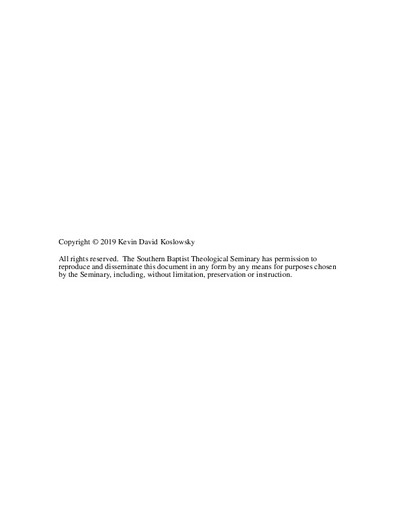| dc.contributor.advisor | York, Hershael W. | |
| dc.contributor.author | Koslowsky, Kevin David | |
| dc.date.accessioned | 2019-11-20T19:03:53Z | |
| dc.date.available | 2019-11-20T19:03:53Z | |
| dc.date.issued | 2019-11-11 | |
| dc.identifier.uri | https://hdl.handle.net/10392/5967 | |
| dc.description.abstract | This dissertation answers the question of how Donald Grey Barnhouse’s sermon illustrations served his homiletical commitment to the authority of the Bible. Illustrations communicate truth “by the shortest route and in the quickest time.”
Chapter 1 states the thesis. While Barnhouse remained within the increasingly liberal Presbyterian Church through his ministry, he did not abandon his fundamental commitments. Despite a strategic shift in ministry partnerships during the last decade of his life, Barnhouse remained faithful to biblical authority throughout his ministry.
Chapters 2 and 3 explore Barnhouse’s theological commitments. Chapter 2 surveys his theological training and his early ministry. He faced ministry challenges and ecclesiastical trial. His training and ministry confirmed his reliance upon the authority of the Bible.
Chapter 3 examines Barnhouse’s lifetime of ministry. Barnhouse’s evangelical priorities were challenged by his New Year’s Resolution of 1953 which revealed his broader willingness to partner with others within his increasingly liberal denomination. The chapter offers evidence of Barnhouse’s continuing commitment to evangelical theology to the very end of his ministry.
Chapter 4 turns attention to Barnhouse’s homiletical strategy based on his own descriptions and an analysis of his published sermons. He considered himself a messenger boy who came with a message from another. Barnhouse’s use of illustrations served his exegetical priorities by making the text clear for listeners in contrast to the strategy of Harry Emerson Fosdick.
Chapter 5 examines the role of sermon illustrations to illuminate a text. The chapter explores the biblical and cultural context to affirm the importance of sermon illustrations and offers a theological and practical framework to analyze Barnhouse’s sermon illustrations.
Chapter 6 analyzes the illustrative strategy through Barnhouse’s published sermons. His preaching is full of analogies, anecdotes, and stories. Illustrations serve his purpose of expounding the text. Each of Barnhouse’s published sermons is examined to identify the importance of illustrations in his preaching.
Chapter 7 offers conclusions on the main research questions. Barnhouse maintained his theological orthodoxy throughout his ministry and his sermon illustrations serve his commitment to Scripture’s authority. Barnhouse considered himself only the telegram boy delivering the message. | en_US |
| dc.subject.lcsh | Barnhouse, Donald Grey, 1895-1960 | en_US |
| dc.subject.lcsh | Homiletical illustrations | en_US |
| dc.subject.lcsh | Preaching | en_US |
| dc.title | Only the Messenger: Donald Grey Barnhouse's Illustrative Preaching as a Commitment to Biblical Authority | en_US |
| dc.type | Electronic dissertation | en_US |
| dc.type | Text | |
| dc.contributor.committee | Vogel, Robert A. | |
| dc.contributor.committee | Haykin, Michael A. G. | |
| dc.type.qualificationname | Ph.D. | en_US |
| dc.publisher.institution | Southern Baptist Theological Seminary | en_US |
| dc.publisher.department | School of Theology | |

